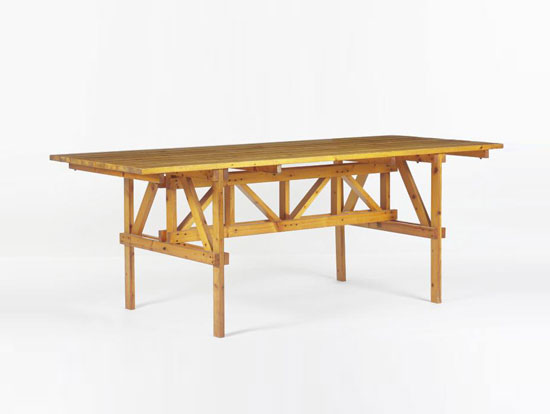
The economic and ecological and aesthetic far-sightedness of Enzo Mari's 1974 Autoprogettazione still blows my mind. Translated variously as "self-projects," and "self-design, self-made," Mari's collection of designs for furniture you could build yourself with just a hammer using cheap, off-the-shelf lumber anticipated several key design principles that resonate right now: DIY; sustainability; small-scale, local production and consumption; simplicity; handmade; hacking commercial products; and the open-source/creative commons movements [the furniture could be built by anyone except a factory or a dealer.]
Mari intended his Autoprogettazione to be made of #2 medium-grade, knotty pine, some of the humblest material on the market. He arranged for a company to pre-cut the lumber and sell it in packs as Metamobile. Naturally, one of these vintage 1974 kit tables sold for $14,400 at auction last fall.
Naturally, a gallery in Chelsea, Demisch Danant, just closed an exhibition of Metamobile furniture which they had made, and which they arranged for Mari himself to sign. Which seems to defeat several purposes of the entire Autoprogettazione concept, but that's life.

I'm looking for photos of the first Metamobile furniture I saw, which is still my favorite: In 2004, Rirkrit Tiravanija produced Mari's square dining table [above] and some chairs in chrome-plated stainless steel. The pieces weighed a ton, but they were truly spectacular, like Koons picnic furniture.
Anyway, we're just in the middle of moving our place in DC, which gives me the occasion to need a bigger, nicer dining room table. Mid-century modernism is too relentlessly tasteful; recent prices of "good" furniture make me laugh out loud. Though I'm an unrepentant Ikea fan, it only goes so far [i.e., no serious furniture]. Mari's furniture feels like the perfect counterpoint to the homogeneous mega-catalogue stores: C&B, Pottery Barn, CB2, West Elm, etc. etc. etc.
So I'm thinking of getting the Truss Table [top] known as the EFFE Table. As a city dweller, I'd have to have it made, or at least have the lumber cut and finished and delivered for my own assembly.
An ex-pat design firm in Japan used sugi, Japanese cedar, to make their EFFE table. For me, I think it's key to use Mari's intended pine. So far, I've sourced two wildly disparate, but potentially interesting woods:
update: Those Demisch Danant pieces appear related to a series of 18 pieces put up at auction last June in Paris. Artcurial has a making of video, though they don't actually show what they made. An EFFE Table went for EUR2,231.












